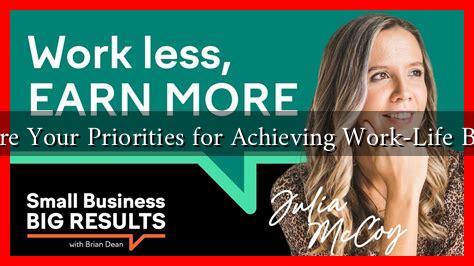-
Table of Contents
What are Your Priorities for Achieving Work-Life Balance?
In today’s fast-paced world, achieving a healthy work-life balance has become a significant challenge for many individuals. The constant demands of work, coupled with personal responsibilities, can lead to stress, burnout, and a decline in overall well-being. Understanding your priorities is essential for creating a sustainable balance between your professional and personal life. This article explores key priorities that can help you achieve work-life balance, supported by research, examples, and actionable strategies.
Understanding Work-Life Balance
Work-life balance refers to the equilibrium between the time and energy devoted to work and personal life. It is not merely about dividing hours between work and leisure but about ensuring that both areas of life are fulfilling and manageable. According to a survey by the American Psychological Association, 61% of adults report that work is a significant source of stress, highlighting the need for effective balance strategies.
Identifying Your Priorities
To achieve work-life balance, it is crucial to identify your priorities. Here are some key areas to consider:
- Career Goals: Define what success looks like for you in your professional life. Are you aiming for a promotion, or do you value job satisfaction more?
- Family and Relationships: Consider the importance of spending quality time with family and friends. Relationships are vital for emotional support and happiness.
- Health and Well-being: Prioritize your physical and mental health. Regular exercise, a balanced diet, and sufficient sleep are essential for maintaining energy levels.
- Personal Development: Allocate time for hobbies, learning, and self-improvement. Engaging in activities you love can enhance your overall satisfaction.
Strategies for Achieving Work-Life Balance
Once you have identified your priorities, the next step is to implement strategies that align with them. Here are some effective approaches:
- Set Boundaries: Clearly define your work hours and stick to them. Communicate these boundaries to your colleagues and supervisors to manage expectations.
- Practice Time Management: Utilize tools like calendars and to-do lists to organize your tasks. Prioritize your workload to focus on what truly matters.
- Embrace Flexibility: If your job allows, consider flexible working arrangements. Remote work or adjusted hours can help you better manage personal commitments.
- Take Breaks: Regular breaks during work hours can boost productivity and reduce stress. Short walks or mindfulness exercises can refresh your mind.
Case Studies: Successful Work-Life Balance
Many organizations have recognized the importance of work-life balance and have implemented policies to support their employees. For instance:
- Google: Known for its employee-friendly policies, Google offers flexible work hours, on-site wellness programs, and generous parental leave, resulting in high employee satisfaction and retention rates.
- Salesforce: This company emphasizes mental health by providing resources and support for employees, leading to a more engaged and productive workforce.
These examples illustrate that prioritizing work-life balance not only benefits employees but also enhances organizational performance.
Statistics on Work-Life Balance
Research shows that achieving work-life balance can lead to significant benefits:
- According to a study by the Harvard Business Review, employees who feel they have a good work-life balance are 21% more productive.
- A survey by Gallup found that employees with a strong work-life balance are 63% less likely to experience burnout.
Conclusion
Achieving work-life balance is a continuous process that requires self-awareness, prioritization, and effective strategies. By identifying what matters most to you—whether it’s career advancement, family time, health, or personal growth—you can create a fulfilling life that integrates both work and personal responsibilities. Remember, it’s not about perfection but about making conscious choices that align with your values and priorities. For more insights on work-life balance, consider visiting American Psychological Association.


